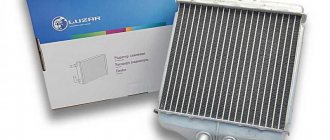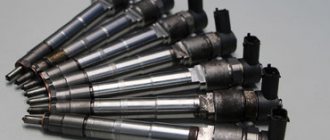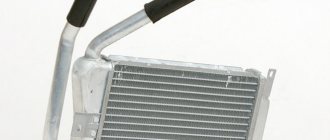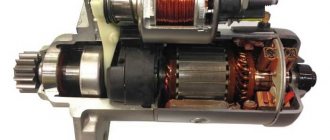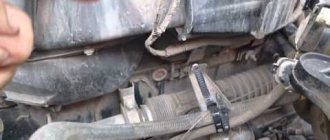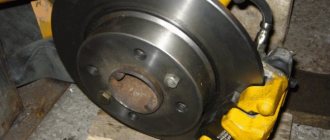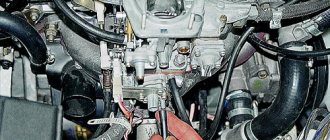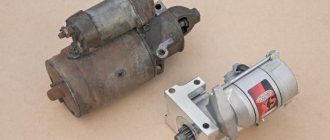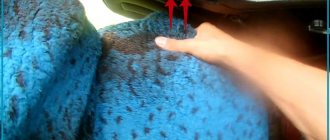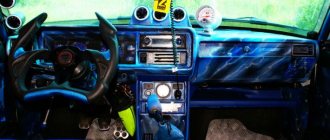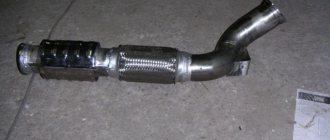Starter VAZ 2107
To start the VAZ 2107 engine, it is enough to turn the crankshaft several times. The design of a modern car allows this to be done without much effort using a starter, which in turn is activated by the ignition key.
Starter purpose
The starter is a DC electric motor and provides the vehicle's power unit with the energy necessary to start it. It receives power from a battery. The starter power for most passenger cars is 3 kW.
Types of starters
There are two main types of starters: reduction and simple (classical). The most common is the first option. A reduction starter has higher efficiency and is smaller in size, and requires less energy to start.
Reduction starter
On the VAZ 2107, the manufacturer installs a reduction starter. It differs from the classic version in the presence of a gearbox, and permanent magnets in the motor winding significantly increase the reliability and efficiency of the device. Such a starter costs about 10% more than a classic one, but at the same time has a longer service life.
A reduction starter differs from a classic starter in the presence of a gearbox
The weak point of such a starter is the gearbox itself. If it is made poorly, the starting device will fail before its usual time. The material from which the gearboxes are made deserves great attention.
Choosing a starter for VAZ 2107
The starter performs the most important functions in a car. Therefore, his choice should be taken as responsibly as possible. On the VAZ 2107 you can install starters from other cars, including foreign cars, with suitable fastenings and technical characteristics. The best option are models with a powerful gearbox - starters from the Chevrolet Niva or the injection seven.
When choosing a starter, you need to consider the following points.
- Domestic ST-221 starters with a power of 1.3 W, which were installed on the first classic VAZ models, had a cylindrical collector. The drive gears were driven by electromagnets. The device of such a starter includes a roller overrunning clutch, a remote control and a solenoid relay with one winding.
- Starter 35.3708 differs from ST-221 only in the design of the rear part and winding, which consists of one shunt and three service coils (ST-221 has two coils of each type).
These starters are more suitable for carburetor VAZ 2107. For sevens with an injection engine, it is proposed to install one of the following options:
- KZATE (Russia) with a rated power of 1.34 kW. Suitable for carburetor and injection VAZ 2107.
- Dynamo (Bulgaria). The starter design is optimized in accordance with consumer requirements.
- LTD Electrical (China) with a power of 1.35 kW and a shorter service life.
- BATE or 425.3708 (Belarus).
- FENOX (Belarus). The design involves the use of permanent magnets. Starts well in cold weather.
- Eldix (Bulgaria) 1.4 kW.
- Oberkraft (Germany). With small dimensions it creates a large torque.
All manufacturers of starters can be divided into original and secondary:
- Original: Bosch, Cav, Denso, Ford, Magneton, Prestolite.
- Secondary: Protech, WPS, Cargo, UNIPOINT.
Among starters from secondary manufacturers, there are many low-quality and cheap Chinese devices.
The average cost of a good starter for a VAZ 2107 varies between 3-5 thousand rubles. The price depends not only on the manufacturer, but also on the configuration, delivery conditions of the goods, marketing policies of companies, etc.
Video: features of the KZATE starter
Preparation for repair and dismantling of the device
It is more convenient to carry out work in a specially equipped room - a garage box. The VAZ 2107 is installed above the inspection hole; for repair and restoration operations, a set of wrenches, a set of heads with a wrench and a device for pressing out the bearing are required. In the event of a malfunction of several other components in addition to the bendix, it makes sense to replace the starter assembly. On a car where there is an injector in the power supply system, repair work is best carried out from below.
The procedure for dismantling the starter on a VAZ 2107 car is as follows:
- Disconnect the battery and remove it from the engine compartment.
- We unscrew the terminal and disconnect the terminal and the wire that supplies power to the starter.
- We unscrew the bolts securing the device that ensures engine starting.
- We remove the unit complete with the bendix feed mechanism from the hole in the housing.
On a VAZ 2107 car, an engine with an injector installed will require a number of additional operations. In this case, replacing the faulty unit is only possible from below. To gain access to the assembly, you need to remove the steel protection and boots covering the engine compartment from below. The remaining operations carried out on the starter are carried out similarly to those described.
Diagnostics of VAZ 2107 starter faults
The VAZ 2107 starter can fail for various reasons.
The starter hums, but the engine does not start
The reasons for the situation when the starter hums, but the engine does not start, may be the following points.
- Over time, the teeth of the starter gear stop engaging (or do not engage well) with the flywheel. This usually occurs when the wrong engine lubricant is used. If you pour thick oil into the engine in winter, the starter will have difficulty cranking the crankshaft.
- The gear that meshes with the flywheel may be misaligned. As a result, the teeth engage with the flywheel ring with only one edge. This is usually due to a failure of the Bendix damper system. Externally, this manifests itself in the form of a characteristic hum or grinding noise and results in broken flywheel or drive teeth.
- There have been disturbances in the power supply system to the starter (brushes are worn out, terminals are oxidized, etc.). Insufficient voltage does not allow the starter to accelerate the flywheel to the required speed. At the same time, the starter rotates unstably, a hum and buzzing appears.
- The pusher fork, which brings the starter teeth to the flywheel crown and removes them after the engine starts, has failed. If this fork is warped, the relay may operate but the drive gear will not engage. As a result, the starter hums, but the engine does not start.
The starter clicks but does not turn over
Sometimes the VAZ 2107 starter clicks, but does not spin. This may happen for the following reasons.
- There are problems with the power supply (the battery is discharged, the battery terminals are loose or the ground is disconnected). The battery should be recharged, the terminals should be tightened, demining should be carried out, etc.
- The fastening of the solenoid relay to the starter housing is loose. This usually happens when driving on bad roads or as a result of over-tightening the mounting bolts, which simply break while driving.
- A short circuit occurred in the traction relay and the contacts burned out.
- The positive cable going to the starter has burned out. It is also possible that this cable may become loose. In the latter case, it is enough to tighten the fastening nut.
- As a result of wear on the bushings, the starter armature became jammed. In such a situation, replacement of the bushings is necessary (removal and disassembly of the starter will be required). A short circuit or break in the armature windings can also lead to a similar result.
- Bendix is deformed. Most often, its teeth are damaged.
Bendix of the VAZ 2107 starter fails quite often
Video: VAZ 2107 starter clicks, but does not turn
Crackling sound when starting the starter
Sometimes when you turn the ignition key, a cracking and grinding sound is heard from the starter. This may occur as a result of the following faults.
- The nuts securing the starter to the body have become loose. Rotation of the starter causes strong vibration.
- The starter gears are worn. When starting, the overrunning clutch (Bendix) begins to make a cracking noise.
- Due to the lack or absence of lubrication, the bendix began to move along the shaft with difficulty. The assembly should be lubricated with any engine oil.
- Flywheel teeth damaged as a result of wear no longer engage with the starter gear.
- The timing drive pulley has come loose. In this case, a crackling noise is heard when the engine starts and disappears after warming up.
Starter won't start
If the starter does not respond at all to turning the ignition key, the following situations are possible:
- The starter is faulty.
- The starter relay has failed.
- The starter power supply circuit is faulty.
- The starter fuse has blown.
- The ignition switch is faulty.
It happened once to start the engine in winter, when the starter flatly refused to rotate through the ignition switch. I stopped the car at the lake where I went fishing. When I was putting it back together, the starting device was inactive. There's no one around. I did this: I found the control relay, removed the wire from it connecting the system to the ignition switch. Next, I took a long 40 cm screwdriver (I found one in my bag) and closed two starter bolts and one retractor bolt. The starter started working - it turned out that sometimes this happens with these devices due to cold and dirt. It is necessary to apply current directly to make the electric motor work.
Starter performance check and repair
First of all, you should clean the starter housing from dirt, which inevitably accumulates on it during the operation of the car. Then connect the mechanism to the battery: the “negative” wire to the starter housing, the “positive” wire to the contact of the traction relay. A characteristic click should follow, and a drive gear will appear in the front “cutout” of the casing. Now use an ohmmeter and check the armature windings for opens and shorts. To do this, you need to open the cover at the back of the starter and remove the brush holders with brushes.
Then connect the ohmmeter with one end to the armature body, and the other - alternately to the sectors of the winding. If there are no short circuits or breaks, the instrument needle will fluctuate from a minimum value of 10 kOhm and above.
Now comes the integrity check of the stator winding (in other words, located inside the housing, along the walls of the cylinder). Here you simply connect the ohmmeter contacts to the copper wire terminals. The arrow of the measuring device should “lie” in the area of the highest value if there are no problems. If there are breaks or short circuits in the windings of the starter or solenoid relay, there is no point in bothering with repairs if you have never dealt with electromechanics and have not encountered the technology of manufacturing electric coils. It is best (and easier) to purchase a complete starter and install a new starter.
Checking the integrity of the stator winding
An operation that can really be called a repair is replacing brushes. You can easily find out that they are erased during diagnostics. It is enough to turn the starter on its side when it is connected to the battery and turns properly. If the unit immediately stalls, brush wear is to blame. Replacing parts is simple and accessible even to a beginner. It was already mentioned above that it is enough to remove the cover at the rear of the starter. When the brush holder is removed, the springs in it will themselves push out the brushes, which will hang on the wires. Replacement is a matter of minutes.
The main thing is to never allow oil or fuel to come into contact with brushes or wire windings. Electrics do not tolerate moisture or grease. Therefore, during any operations with starter parts, especially when assembling it, act carefully and, if possible, stay away from liquids and fuels and lubricants.
There is one rare malfunction when the starter turns on, but nothing turns. In this case, the bendix is to blame - a device that prevents the teeth of the drive gear from sharply hitting the flywheel. Its main malfunctions are wear of the rollers, the gear itself, weakening of the pressure spring or unsuitability of the lubricant. This part is inexpensive, changes quickly, and therefore there is no point in bothering with repairs. It is better to purchase it in a store; replacement is done on the “return” when the starter is being assembled.
Sometimes the armature bushings need to be replaced, but this is extremely rare because they are made of very reliable material and wear only appears after a really long period of use. There are only two of them - in the toe and back cover. The process of knocking the bushings out of their seats is usually confusing, but by choosing the right attachment, you won’t ruin anything. Next, a part of the required diameter is lubricated and pushed into the hole. If things get tight, don’t use more force; it’s better to sand the bushing body and try again, otherwise the socket may simply burst.
Checking the VAZ 2107 starter
If the engine of a VAZ 2107 does not start, usually check the starter first. This is done as follows.
- The starter is removed from the body and cleaned of dirt.
- The output of the traction relay is connected by a separate wire to the battery positive, and the starter housing to the negative. If the working starter does not start to rotate, the test continues.
- The back cover of the device is removed. Brushes are checked. The coals should not be erased by more than a third.
- A multimeter measures the resistance of the stator and armature windings. The device should show 10 kOhm, otherwise there is a short circuit in the circuit. If the multimeter readings tend to infinity, there is a break in the coil.
- The contact plates are checked with a multimeter. One probe of the device is connected to the body, the other to the contact plates. The multimeter should show a resistance of more than 10 kOhm.
During the process, the starter is checked for mechanical damage. All faulty and damaged elements are replaced with new ones.

